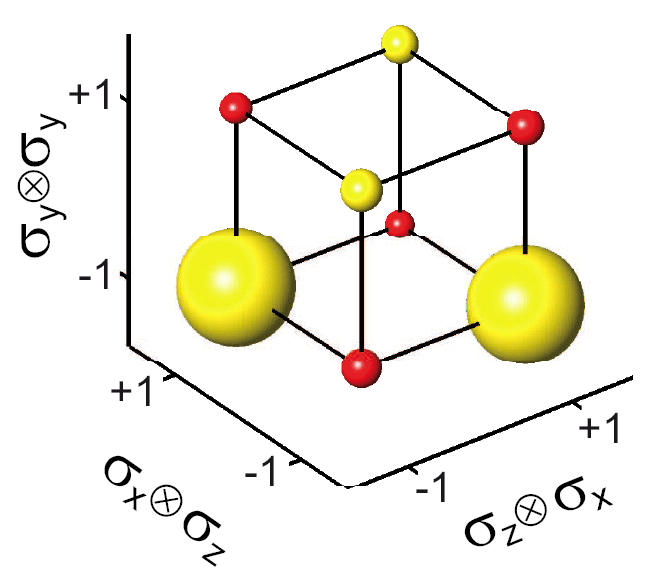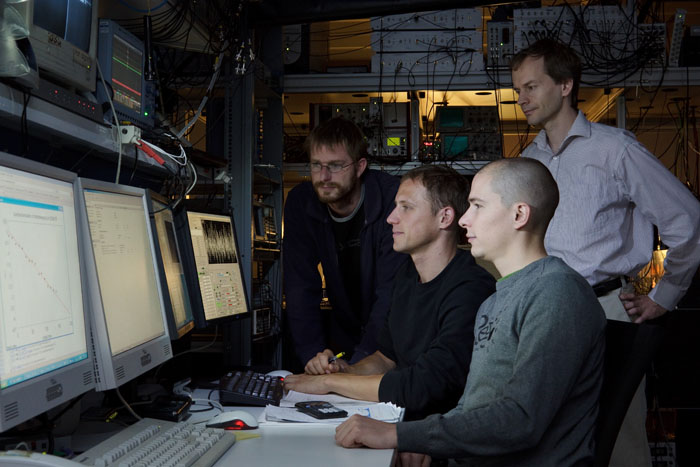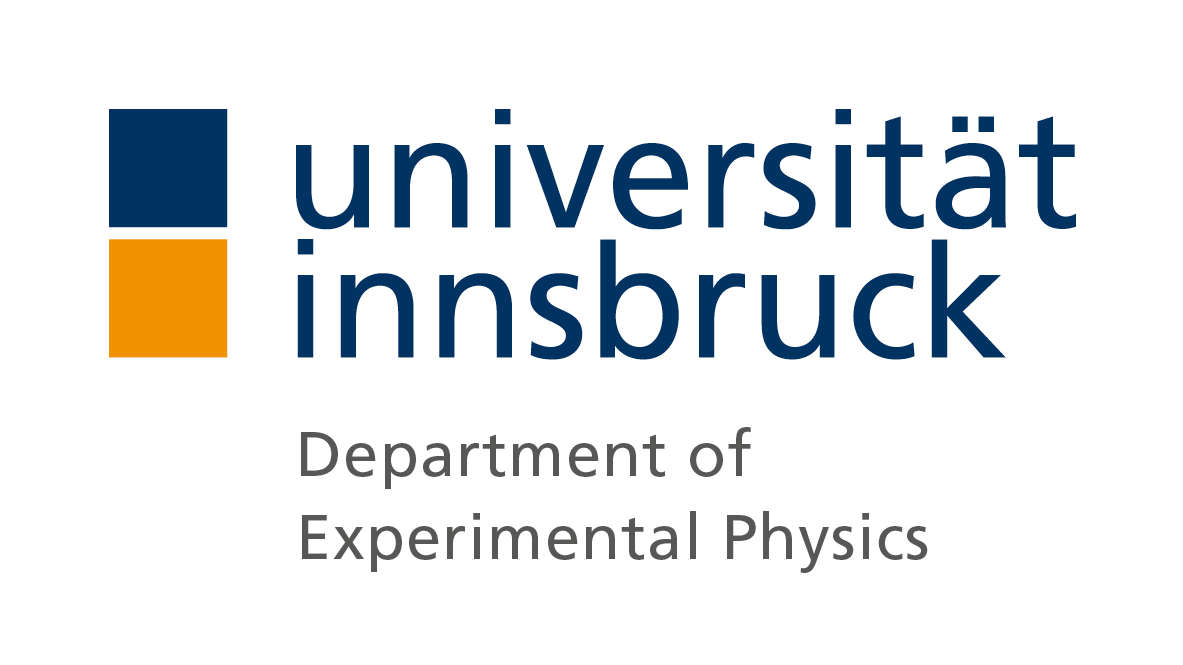State-independent experimental test of quantum contextuality
Quantum mechanics is a physical theory that was developed nearly 90 years ago. It has had an overwhelming success and its predictions have been confirmed in numerous experiments. Nevertheless, many physicists still puzzled by the axioms of the theory have been searching for an explanation of quantum physical predictions in terms of a classical theory. This development started with the work of A. Einstein, B. Podolsky and N. Rosen. A major breakthrough was obtained by J. Bell when he derived inequalities that made it possible to experimentally test classical theories based on hidden variables. Since then, many experiments have been carried out on space-like separated quantum systems to test the concept of locality in hidden variable models.
Another notion of hidden variable models, non-contextuality – the property that any observable has a measurement value which is independent of other compatible measurements being carried out at the same time – is in conflict with quantum theory as a theorem formulated by Kochen, Specker and Bell shows. For a long time it has been debated whether non-contextuality could be experimentally tested at all, and only recently first tests of quantum contextuality have been proposed and undertaken photons [1] and neutrons [2]. However, these tests were incomplete and have been criticized later on.
The experiment we have carried out [3] realizes a proposal made by A. Cabello published in 2008 [4] and is based on repeated quantum measurements on individual quantum systems. In our work, we use a pair of trapped ions for testing quantum contextuality by performing successive measurements on the ions and analyzing the measured correlations. The results of our experiment clearly show that contextuality is a property of nature; moreover, revealing this property does not require the generation of special quantum states or quantum entanglement. This also sheds new light on the debate to which extent entanglement is the main resource in quantum information science.
Quantum non-demolition measurements of spin correlations
In our experiment, quantum non-demolition measurements play a key role. For example, if each of the ions is prepared in a superposition of two electronic states, then a quantum measurement could be carried out to answer the question whether both ions are in the same or in different electronic states. Mathematically, this measurement corresponds to measuring the observable sz(1)sz(2). This observable could be measured by determining the states of ion 1 and ion 2 individually by fluorescence measurements and subsequently correlating the results. Measurement correlations for singlet state However, this kind of measurement actually provides more information than required since the state measurements tell us also about the individual states of both ions, i.e. measurement of the observables sz(1) and sz(2). Therefore, the measurement perturbs the system stronger than necessary. A better measurement scheme is the following: a controlled-NOT gate operation is applied to the ions, followed by a fluoresence measurement of the target ion and another controlled-NOT gate. Here, the first gate operations maps the information whether both ions were in the same electronic state onto the target ion which is then read out. The final gate operation is applied to restore the original state to make sure that at the end of the measurement the ions are indeed in an eigenstate of the measured observable. In this way, the observable sz(1)sz(2) is measured in a minimally invasive way as the measurement provides no information whatsoever about any other observable.
 The figure to the right shows a visualization of measurement correlations that we found when measuring the spin correlations sz(1)sx(2), sx(1)sz(2), and sy(1)sy(2), for pairs of ions prepared in singlet states. Each individual measurement has outcomes +1 or -1 so that the joint measurement outcomes are given by triples (+1,+1,+1), (+1,+1,-1) and so on which can be associated with the the corners of a cube. The volume of the spheres centered at the cubes visualizes the frequency with which a certain measurement outcome was found in the experiment, the colour represent the measurement correlation (i.e. the product of the three individual measurement results (yellow: +1, red: -1). The measurement results shown in the figure confirm that the singlet state is an eigenstate of sy(1)sy(2) as the detection yields nearly always a value of -1 for the measurement of this observable. The singlet state is not an eigenstate of sz(1)sx(2)or sx(1)sz(2); for these measurements, both values, +1 and -1, appear with equal probability.
The figure to the right shows a visualization of measurement correlations that we found when measuring the spin correlations sz(1)sx(2), sx(1)sz(2), and sy(1)sy(2), for pairs of ions prepared in singlet states. Each individual measurement has outcomes +1 or -1 so that the joint measurement outcomes are given by triples (+1,+1,+1), (+1,+1,-1) and so on which can be associated with the the corners of a cube. The volume of the spheres centered at the cubes visualizes the frequency with which a certain measurement outcome was found in the experiment, the colour represent the measurement correlation (i.e. the product of the three individual measurement results (yellow: +1, red: -1). The measurement results shown in the figure confirm that the singlet state is an eigenstate of sy(1)sy(2) as the detection yields nearly always a value of -1 for the measurement of this observable. The singlet state is not an eigenstate of sz(1)sx(2)or sx(1)sz(2); for these measurements, both values, +1 and -1, appear with equal probability.
To carry out such quantum non-demolition measurements of two-ion observables, we need to be able to perform gate operations after a fluorescence detection was performed.  As fluorescence measurements strongly perturb the vibrational state of the ion string, the gate operation needs to be independent of the vibrational quantum state. The Molmer-Sorensen gate demonstrated by us using a pair of 40Ca+ ions [5] has exactly this property as long as the extent of the motional wave packet is still small compared to the wavelength of the gate laser. In addition, the high gate fidelity of up 98% was crucial for successfully carrying out the experiments as up to six entangling gate operations were needed for correlating a set of three observables.
As fluorescence measurements strongly perturb the vibrational state of the ion string, the gate operation needs to be independent of the vibrational quantum state. The Molmer-Sorensen gate demonstrated by us using a pair of 40Ca+ ions [5] has exactly this property as long as the extent of the motional wave packet is still small compared to the wavelength of the gate laser. In addition, the high gate fidelity of up 98% was crucial for successfully carrying out the experiments as up to six entangling gate operations were needed for correlating a set of three observables.
See also: Nature News & Views
Literature
[1] Experiments towards falsification of noncontextual hidden variable theories. M. Michler, H. Weinfurter, M. Zukowski, Phys. Rev. Lett. 84, 5457 (2000)
[2] Quantum contextuality in a single-neutron optical experiment, Y. Hasegawa, R. Loidl, G. Badurek, M. Baron,. H. Rauch, Phys. Rev. Lett. 97, 230401 (2006)
[3] State-independent experimental test of quantum contextuality, G. Kirchmair, F. Zähringer, R. Gerritsma, M. Kleinmann, O. Gühne, A. Cabello, R. Blatt, C. F. Roos, Nature 460, 494 (2009) pdf
[4] Experimentally testable state-independent quantum contextuality, A. Cabello, Phys. Rev. Lett. 101, 210401 (2008)
[5] Deterministic entanglement of ions in thermal states of motion, G. Kirchmair, J. Benhelm, F. Zähringer, R. Gerritsma, C. F. Roos, R. Blatt, New Journal of Physics 11, 023002 (2009) pdf
Downloads
Financial support
We are financially supported by Österreichische Akademie der Wissenschaften, Universität Innsbruck, Fonds zur Förderung der wissenschaftlichen Forschung (FWF) within the program "Control and Measurement of Coherent Quantum Systems", the European network "SCALA" as well as IQI and IARPA.

